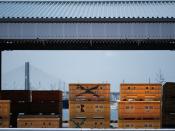The term "environmental justice" or "environmental racism" was established more then a decade ago to describe the reality throughout North America, which visible minorities are more likely to live near dumps and toxic waste sites.
The United States Environment Protection Agency defines Environmental Justice "as the fair treatment and meaningful involvement of all people regardless of race, color, national origin, or income with respect to the development, implementation, and enforcement of environmental laws, regulations, and policies. Fair treatment means that no group of people, including a racial, ethnic, or a socioeconomic group, should bear a disproportionate share of the negative environmental consequences resulting from industrial, municipal, and commercial operations or the execution of federal, state, local, and tribal programs and policies."
In British Columbia, examples of environmental racism surround the province, the Salmon Aquaculture is a good example. The First Nation communities have been subjected as the main victims towards BC's salmon aquaculture projects.
Salmon aquaculture or salmon farming in BC commenced in the 1970's and where operated by small local firms. However, due to poor environment conditions, disease outbreaks, and a competitive market many farms went out of business or were purchased by larger companies.
By the late 80's First Nations, local communities, fishermen, and environmentalists were starting to be concerned about the number of fish farms and their impact on the ocean and the local communities that surrounded the farms.
In 1995, Fisheries and Oceans Canada combined with the provincial government implemented a halt on the fish farm industry.
In BC most fish farms raise their salmons in open net cages, which ultimately allows for waste to fall directly into the ocean. Each pen usually contains approximately 50,000 fish, and a farm on average will contain 14 pens. 50,000 fish times 14 pens equals 700,000 fish, in result...



Well done
good job, it was nicely formated, and your statements were rite down to the point!
6 out of 6 people found this comment useful.